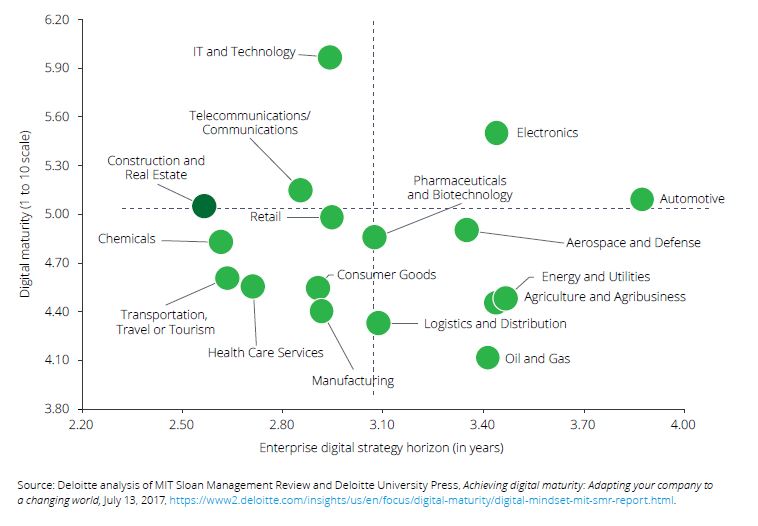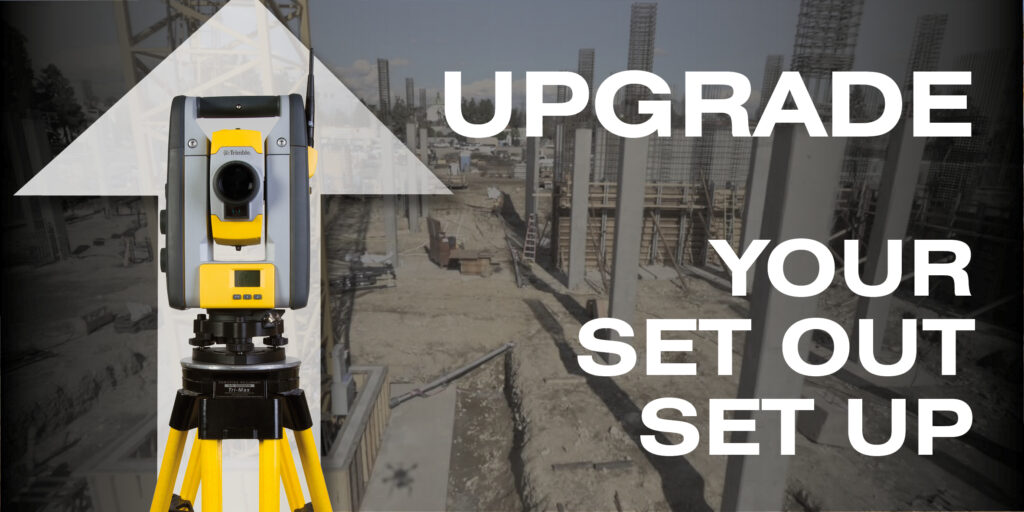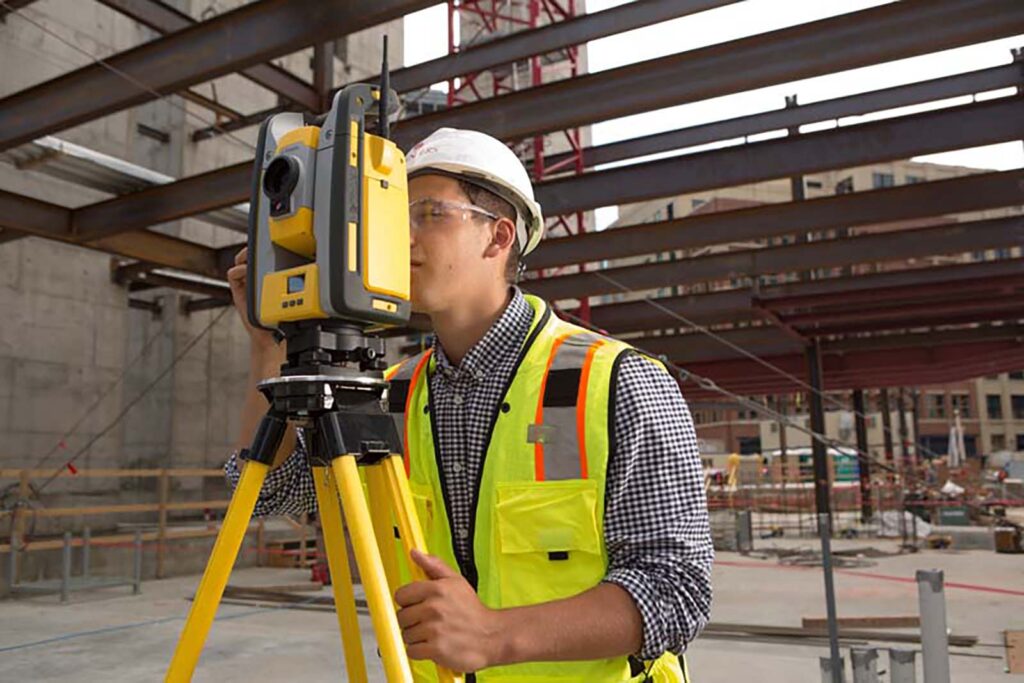A recent report by Deloitte on the development of the construction and engineering industry until 2050 identified the key trends set to shape the industry, the priorities and challenges that construction professionals should be aware of, and the technologies and solutions that are on hand to help us meet these challenges.
The report defines Connected Construction as an ecosystem – a connected network of capabilities such as collaboration, real-time project visibility, worker safety and data that promotes the most effective, efficient, productive and safe delivery of projects.
As a key equipment supplier to the sector, in both Ireland and the UK, KOREC believe that it is vital for our customers to be aware of these findings, and to present solutions for how we can tackle the challenges, head-on.
We’ve reviewed the report and pulled out what we believe to be the key findings, which we’ll present over 3 sections – the challenges, the key technologies involved, and finally, the opportunities.
The Opportunities
We’ve identified four broad areas of opportunity that focus around; processes, data, people and future-proofing. We believe there are huge gains to be made by forward-thinking firms that take the time now to investigate the technologies that are available to them.
Streamline your Processes
A digital record of project plans (literal 2D & 3D plans, as well as scheduling) brings a wealth of information to your fingertips. Construction software such as Trimble FieldLink create a fully-connected flow of information both from and to the office allows you to avoid guesswork, make informed decisions on site, and cut down on the risk of costly errors. Other tools such as Bluetooth beacons, managed WiFi and on-ground sensors can track equipment performance and maintenance – equipping you with the latest information you need in order to make informed decisions.
Leverage your data’s full potential
Office-designed BIM models contain a huge amount of valuable information and data about a project – why lose a huge chunk of that value when bringing the design onto site? With connected, digital and paperless solutions, you are ensuring that the data you are working to on site, is identical to the data prepared in the office. What’s more, with tools such as the XR10 it’s simple to mark-up changes on site – which can then immediately be updated on the BIM. A virtuous cycle of powerful information, between the office and the build site.
Upskill your Staff
Autonomous or semi-autonomous technologies, such as robotic total stations, drones, and even robots, can take the slack when it comes to hazardous, repetitive or unskilled tasks. For example, a robotic total station requires only one semi-skilled operator, not two – immediately reducing personnel on site – or freeing them up for other tasks. Looking further afield, robots (or co-bots as they’ve been termed) such as Spot the Dog can be programmed by their human colleague to undertake manual tasks – even working throughout the night and at weekends to drastically cut programme schedules.
Future-proof your Business
The construction and engineering sector is at somewhat of a crossroads – huge global demand, a wealth of interconnected technologies available, stubbornly-low profit margins, growing concerns around environmental sustainability, and a well-publicised skills shortage.
In order to attract a new generation of educated, informed and skilled workers to the profession, the sector must engage with currently-available connected technologies, which will in turn drive down costs, and drive demand for new solutions.
At a business level, those organisations (such as Nugent Manufacturing) that take a long-term, joined-up and open-minded approach are more likely to experience the gains in productivity, efficiency, safety and profit margins that those who operate in a business-as-usual manner. And it is those digital-ready organisations that are best placed to attract the top talent to ensure their future growth.
Key Technologies
The report identified 6 key technologies, some of which are already beginning to make major inroads into the efficiency and productivity of our industry;
1.Robotics
Dull, laborious and repetitive tasks are better performed by a robotic assistant (see Spot the dog from Trimble & Boston Dynamics!), freeing up their human colleagues for safer, higher-skilled tasks
2. Automation
The growth of AI could lead to the rise of intelligent buildings – structures that learn how to run and operate themselves – saving energy, money and resources
3. 3D-printing
Having accurate, digital design information (as provided by the Trimble X7 3D scanner) allows for complete 3D-printed assets (including the world’s first inhabited 3D printed house)
4. Autonomous Vehicles
High-accuracy data of construction sites paves the way for robotic ‘workers’ to work around the clock – leading to huge reductions in project delivery timescales
5. Unmanned Aerial Vehicles
Rapidly becoming a fixture of construction sites across the country, UAVs enable the rapid and contact-free survey of large and difficult to access areas – ideal for regular project progression updates and site inspection.
6. Virtual, Augmented and Mixed Reality
Visualise completed projects before ground has even been broken – augmented reality solutions such as SiteVision allow for unbuilt, underground or unseen features to be viewed in-situ, whilst wearable mixed-reality such as the XR10 allow contractors (as well as clients) to undertake walkthroughs of complex sites.

There is a link to download the full 16-page report at the bottom of the page.
The Challenges facing our industry
- Only ¼ of the global infrastructure we’ll need by 2050 exists today. Every single day, over 200,000 people move into the world’s urban centres.
- The Construction industry is only looking 2.5 years ahead when it comes to digital strategy – ranking bottom out of 17 industries for forward-thinking and planning.

- Profitability and margins are stubbornly low – earnings averaging just 5% of sales. Not only does this affect the bottom line, it also deters higher-skilled graduates from entering the profession
- Engineering and construction firms experience an average of 82-days outstanding sales (i.e. unpaid invoices) – longer than all other industries. Again, this affects cash-flow and stunts the ability of the business to invest.
Find Out More…
Case Study – how one KOREC customer are punching well above their weight by investing in a complete field-to-finish digital construction workflow
- Download the complete Deloitte report
- Check out our complete range of laser scanners, robotic total stations, mixed reality and office-to-site software
- Speak to us about our range of digital construction tools
KOREC Group have cemented their dedication to the construction industry, by becoming a signed-up member of COMIT.
Short for Construction Operation & Maintenance through Innovative Technology, the organisation’s mission is to foster greater ties between the construction and technology industries, in order to speed up the adoption of innovative technologies in the sector.
As a leading supplier of cutting-edge construction solutions (such as the X7 laser scanner, RTS total stations and XR10 mixed reality headset) KOREC has the solutions, the experience and the expertise to drive forward productivity, safety & collaboration in the sector.

KOREC is a leading supplier of digital construction solutions to both the UK & Irish construction markets
KOREC join major industry players such as Balfour Beatty, BAM Nuttall, Costain & Morgan Sindall in the group, and hope to play a strong role in communicating the effectiveness of digital construction workflows to industry partners – both small and large.
KOREC make their COMIT debut this Friday at the ‘Happy Hour’ event, joining a panel discussion on the theme of ‘How to leverage data from the field to drive greater Quality, Safety & Productivity on your sites’.
KOREC’s UK Sales Director Mark Reid will represent the company at the session, and join the panel discussion following a presentation by fellow member Novade.
This will be followed by KOREC’s own presentation to the COMIT members at a session in May.
Find out More
- To find out more about the work of COMIT, take a look at their website
- Take a look at KOREC’s digital construction solutions
- Follow KOREC Construction on LinkedIn
Setting out is a laborious, time-consuming yet vital stage of the construction process.
With our February trade-up offer, you can ensure you have the most robust, most productive and most cost-effect setting out workflow available.
To make things better, we’ll give you £4000 / €4500 to upgrade your old survey kit for a brand-new, setting out solution built for the digital construction site.
For more details of this limited time setting out offer, download our handy 1-page PDF.
Prefer to speak to an expert? Get in touch via our Contact page.

Find Out More
- Read how the RTS773 helped Felix O’Hare deliver a complex project 6 weeks ahead of schedule – Customer Story
- Read our handy blog ‘Visual Setting Out – 5 reasons why’
- Browse the full range of robotic total station solutions
How would you like to complete five times the amount of work, with just 1 operative?
More construction contractors are realising the value of visual setting out with robotic total stations. They’re seeing firsthand the gains in speed, efficiency, and accuracy. These benefits translate to reductions in rework, schedule delays, and other costly problems, all of which contribute to a robotic total station’s ability to pay for itself many times over.
What is Visual Setting Out?
But not all robotic total stations are made the same. While prism pole layout is the norm, some robotic total stations also offer a laser pointer. Using a laser is referred to as visual setting out, and it works especially well in structures and buildings that are already erected. When you use a robotic total station that allows you to do both prism pole layout and visual layout, you get the ultimate in flexibility and versatility. Here are five reasons to take a closer look at visual setting out.
Reason 1 – SPEED
When conditions permit the use of a laser, you’re able to speed up the setting out process considerably. You can turn on the laser and stand back as it automatically points and measures, reducing the time needed to position and locate the prism pole. Integrated software in the robotic total station, like Trimble FieldLink, guides you to each point and allows you to switch between surfaces, such as from the floor to the ceiling. You can eliminate extra steps, which cuts the time needed to complete set out significantly, while also gaining greater precision.
Reason 2 – ACCURACY
To get an accurate measurement with a prism pole, the pole needs to be perfectly plumb. Even a slight misplacement could produce a measurement that’s a few cm off. This type of human error is difficult to avoid when you’re relying on manual processes. But when you rely on Trimble’s patented visual set out technology to let the robotic total station do the adjustments and calculations for you, you can achieve much greater accuracy.
The precision of visual set out is especially beneficial for MEP contractors. Pipes and floor drains, for example, have to be accurately placed to drain correctly and pass inspection. Electrical work, HVAC, and sprinkler systems have to be placed accurately at the right elevations to clear other systems and avoid clashes. With the accuracy the laser provides, you can have greater confidence that your work will be set out and installed correctly.
Reason 3 – EFFICIENCY + REDUCTION OF PERSONNEL
Manual setting out is a time-consuming process that can take weeks or longer depending on the size of the project. It also requires that you have enough pros available to complete the work—a challenge given the construction skills shortage. With a robotic total station, though, only a single operative is needed to operate the instrument, whether using the prism pole or the laser. And because of the automated capabilities of the laser, fewer steps are needed to set out points, which significantly reduces the amount of time needed.
In fact, in many cases, you can complete 5 times the amount of work with one person. You’re able to deploy the setting out resources you have more efficiently and across more projects.
Reason 4 – SAFETY
Busy jobsites tend to be full of potential hazards, and performing set out in the midst of these hazards can be risky. With the visual setting component of a robotic total station, you can shoot the laser over 100 meters, which means you don’t have to physically make your way across the jobsite to measure a location. You’re able to avoid trip hazards or other potentially dangerous areas. You can also reduce the use of ladders, which pose one of the greatest safety risks to construction workers.
Reason 5 – COST & ACCOUNTABILITY
Because you can perform setting out more quickly with the laser, you’re more likely to meet the project schedule. And any time you can stay on schedule, you’re improving your likelihood of staying on budget. In addition to performing set out, a robotic total station also allows you to create a record of work performed. Should you receive an RFI or have to resolve a dispute over charges, you can reference this documentation to show what you did and why. This same feature lets you quality check your work as you go so you can identify and resolve problems before they turn into profit-robbing rework.
See our full range of Robotic Total Stations for Construction, and other BIM tools.



